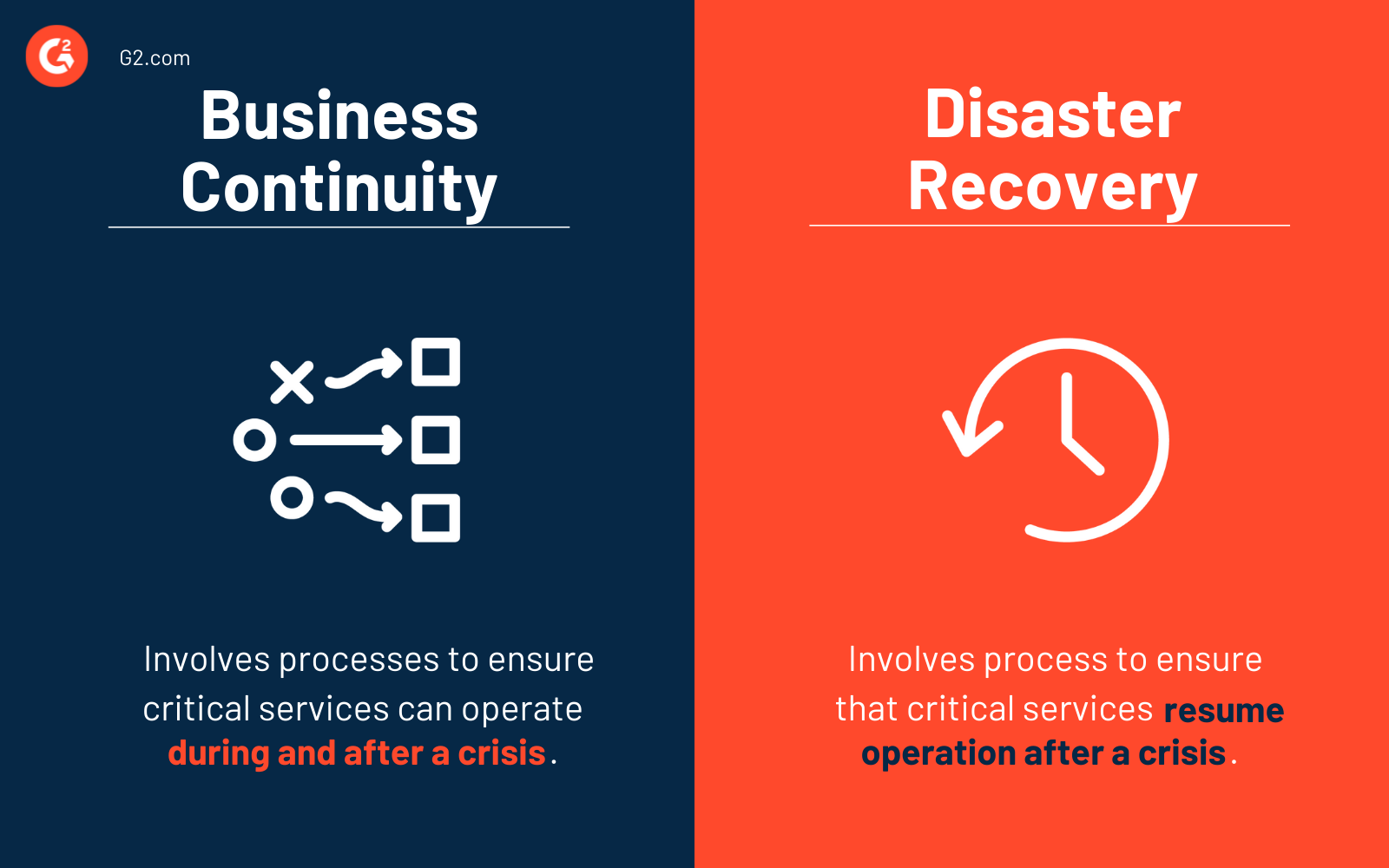An ounce of preparation is worth a pound of cure.
No matter the size of your organization, the risk of business disruption is real. Many hazards can disrupt critical business functions, including physical or cyberattacks, natural disasters, pandemics, and supply chain impacts.
Business continuity is the cornerstone of your organization's ability to respond to disruptions. It addresses key business risks that can lead to disruptions and helps plan the expected response.
What is business continuity?
Business continuity is the process of identifying key players and strategies in your organization and planning how to recover from emergency events. Business continuity planning is often performed in conjunction with emergency management for conducting the actual emergency response.
Common tech services geared toward business continuity include disaster recovery as a service (DRaaS) software for infrastructure failures and managed security policies that guard against more sophisticated cyberattacks, among others.
As business continuity is essential to keep your IT infrastructure under control during a disaster, it should be developed through a well-orchestrated process.
Business continuity has two aspects:
- Business continuity planning (BCP) defines risk management processes and techniques to prevent mission-critical service outages and resume full operations as quickly and efficiently as feasible. These plans often include processes, manual workarounds, and backup procedures to deal with the loss of workspace, infrastructure, people, software, and vendors.
- Business continuity management (BCM) is a holistic approach to risk assessment and its impact on operational processes. It combines emergency response, crisis management, disaster recovery, and business continuity.
Why is business continuity important?
Every institution, from small businesses to giant corporations, relies on digital technology to generate revenue, deliver services, and support consumers who want services and data available at all times. Customers aren't the only ones who suffer from disruption. A fire, flood, ransomware attack, or other disasters can cause significant financial losses, harm the company's image, and, in the worst case, force a company to shut down permanently.
Organizations emphasize business continuity because sustaining vital services during a crisis or disruption can mean the difference between success and failure. If critical business capabilities fail, a short recovery time for system restoration can be of great value.
Business continuity can:
- Ensure the safety of staff, contractors, clients, and visitors
- Reduce the impact of an interruption by hastening the recovery effort
- Protect a business’ image, processes, and stakeholder relationships
Planning and preparation are essential to a holistic business continuity strategy. Professionals can assist a business in developing a resilience plan. Establishing such a strategy is a time-consuming process that involves conducting a business impact analysis (BIA) and risk analysis and designing BC plans, tests, exercises, and training.
For example, recovering massive data sets from a backup can take a painfully long time. Therefore, failover to a distant data center is a preferable alternative for companies with large datasets.
A contingency plan can be the last alternative when resilience and recovery efforts fail, or an unexpected event occurs. A contingency plan contains a practiced approach and a strategy for last-resort needs. These needs can range from finding third-party support to locating a second site for urgent office space or remote backup servers.
Types of business continuity risk
Business continuity risks greatly affect organizations. Covid-19 pandemic’s impact on businesses worldwide is perhaps the best example of business continuity risks.
Companies suffered severe losses as they closed permanently, and customers were forced to remain indoors during lockdowns. Many employees were laid off as businesses struggled to pay wages and rent.
A business continuity plan can help prevent such potential threats and maintain smooth and effective operations. Let's look at five primary business continuity risks that a company should monitor and manage:
- Cyberattacks are a huge concern. Cybercriminals can harm a company's reputation and finances by causing network and system damage. For example, in October 2020, Clop ransomware hit Software AG, a German technology company. The cybercriminals threatened to dump customer data (such as contact information and other personally identifiable information (PII)) if the business didn't pay a $23 million ransom.
- Data breach occurs when essential, private, and sensitive information is released or revealed to an untrustworthy person or environment. Data breaches include the loss of USB drives, mobile or computing devices, laptops, and computer networks. Such breaches can expose critical company and customer information to unknown individuals and cause significant harm to the company.
- Terrorism threatens a country or community. It instills dread and uncertainty among the general public. Employees and security forces in a company are ill-equipped to deal with terrorist attacks. Terrorism's most visible consequences are property destruction and business disruption. Moreover, tourism and daily life are highly affected after a terrorism event. It takes some time for businesses to resume normal activities.
- Fires typically occur suddenly and without notice. Anything can cause them to malfunction business property or abuse organizational tools and devices, such as faulty or overheated information technology (IT) setups. Maintaining a fire control strategy that includes fire brigades, alarms, and extinguishers as a preventive step to prevent and fight fires is necessary for all types of businesses.
- Supply chain disruption: Businesses should also be cautious about supply chain disruption. Natural calamities such as floods, hurricanes, earthquakes, tsunamis, and storms frequently cause such disruption. As a result, the distribution system between companies and vendors collapses, and the supply chain suffers.
What does business continuity include?
Business continuity addresses the planning and preparation essential to strengthening and equipping a company to conduct vital business services during a crisis. It determines, plans for, and develops:
- The teams necessary to manage emergencies
- How to communicate with consumers, providers, and other intermediaries to provide accurate information and assistance
- The sequence and timing essential to restore operations
- How to ensure that clients continue to receive services or products
- The essential tech to support business workflows
- How to assist employees in the event of an emergency
- Where and how to move internal stakeholders if business sites are impacted or unavailable
- Workaround procedures that come into play when processes are unavailable
- Regular exercises to ensure that plans and actions fulfill standards and work during an actual incident
- Documentation of the business processes and necessary steps
Proper business continuity incorporates different classes of response. As everything isn’t mission-critical, it's essential to separate what’s most critical to keep running and what can wait a bit longer. It's vital to be unbiased about recovery time objectives (RTOs) and recovery point objectives (RPOs).
Components of a business continuity plan
A business continuity plan has three major components: resilience, recovery, and contingency.
An organization's resilience improves when it plans essential services and infrastructure considering multiple crisis scenarios, such as workforce rotations, data redundancy, and capacity surplus. Ensuring resilience against various situations can also help companies maintain vital services on and off-site without interruption.
Rapid recovery is critical to restoring services following a disaster. Establishing recovery time objectives for different systems, networks, or apps can determine which components need to be regained initially. Other recovery options include resource inventories, partnerships with third-party companies to take over business operations, and modified facilities for mission-critical operations.
A contingency plan includes techniques for a range of external events and a hierarchy that distributes tasks within a company. These tasks can also involve replacing hardware, acquiring emergency office space, assessing damage, and hiring third-party providers.
Business continuity vs. disaster recovery
Business continuity and disaster recovery (DR) closely align and help an organization stay active after a disaster. Integrating business continuity and disaster recovery into a single term, BCDR stems from a growing understanding that business and technology executives should work closely to prepare for crisis solutions rather than building strategies in isolation. BCDR aims to reduce risks and get an organization up and running as quickly as possible after an unplanned outage.

Business continuity is more proactive and refers to managing mission-critical systems and processes to ensure continued operation during and after a crisis. It includes more thorough planning that targets long-term threats to business success. Business continuity typically focuses on organizational processes.
Disaster recovery is more reactive and involves specific measures for a business to follow after a disruption to resume operations. Disaster recovery takes place after the disaster, with reaction times ranging from seconds to days. DR deals with the technical infrastructure.
Unlike business continuity plans, disaster recovery strategies can also include additional employee safety precautions such as fire drills or emergency supplies. Combining the two helps a company focus on operations and employee safety simultaneously.
Disaster recovery is an essential component of business continuity programs that make data accessible after a disaster. This aspect is included in BC, but it also considers risk management and other preparedness a company needs to stay afloat during an emergency.
Business continuity and disaster recovery have some parallels. They both consider various unforeseen events, such as cyberattacks, human mistakes, and natural disasters. They focus on business recovery, especially for mission-critical applications. In many situations, the same team works on both BC and DR.
Successful business continuity plans reduce operational downtime, while effective disaster recovery plans reduce aberrant or inefficient system functions. Businesses can fully prepare for emergencies only by integrating the two strategies.
Business resilience vs. business continuity
While business continuity plans are critical for success in an unpredictable world, business resilience goes beyond plans to foster an agile culture.
Business resilience is an organization's willingness to adapt to situations and function efficiently in the face of external or internal risk or change. Resilient businesses can adapt to and handle security, risk, preparedness, and survival threats.
Business resilience responds to risks and incorporates business continuity and crisis management. It also encompasses a company's ability to adapt to new surroundings and merge several disciplines into a single set of integrated procedures. It's a more strategic approach to risk management. Business resilience is customized for each business since different companies have different needs.
Simply put, it’s about absorbing a punch and rebounding from it. For a business, this means that in the event of a disruption, you have measures in place to absorb the impact without severely interrupting your activities. Companies need to follow certain principles to create a framework for successful organizational resilience.
Resiliency usually requires:
- Behavior consistent with a shared vision and goal
- An up-to-date understanding of a company's environment
- The ability to absorb, adapt, and respond to change effectively
- Good leadership and management
- Coordination across managerial disciplines and contributions from technical and scientific experts
Business continuity standards
Business continuity standards promote uniformity across a particular business continuity approach. Following norms and set processes allows businesses to achieve quick turnarounds.
- ISO 22301:This BC standard establishes a structure for response tactics and recovery methods via a defined management system. It includes strategic planning, designing, implementation, ease of operability, monitoring, assessment, management, and timely upgrades.
- ISO 22313:This protocol is an extension of ISO 22301 that highlights particular regulatory clauses.
- ISO 27001: This strategy focuses on information security management systems (ISMS). It involves the design, implementation, management, and fostering a culture of ongoing improvement.
- ISO 22320: This BC standard defines incident response conditions and a fundamental approach to the command structure, operational information, and engagement with incident response groups.
- ISO 31000: This is a general risk management framework that can be adapted to any business, irrespective of the type, size, or complexity of its activities. It covers risk management and effective resource allocation.
- ISO 27000: This is a set of regulatory rules applicable to ISMS. It focuses on information system security, including financial data, personnel profiles, consumer data, and third-party databases.
- ISO 28000: This standard describes the requirements for a security management system from a supply chain management standpoint.
- NFPA 1600: It’s a reference source that explains how to prepare for, address, and recover from disasters.
- NFPA 72: This standard provides best practices for deploying fire detection, signaling, alarm, mass notification, weather management, and similar notification systems to notify business continuity teams of potential dangers.
Business continuity tools
You can choose from a wide range of business continuity tools, each with its own set of features:
- Backup: Data backup is one of the most basic techniques to ensure business continuity. While maintaining data off-site or on a remote drive ascertains some business continuity, other systems are necessary to back up the IT infrastructure and keep it operational in the case of a disaster. Backup software safeguards company data by replicating data from servers, databases, desktops, and other devices when human mistakes, damaged files, or physical calamities render essential data inaccessible.
- Backup as a Service (BaaS): Backup as a Service is comparable to backing up data at a distant location, but a third-party source performs it. Once again, the data is backed up, and the IT infrastructure isn't.
- DRaaS: DRaaS migrates an organization's data processing to a cloud platform. DRaaS vendors offer a subscription or pay-per-use model for businesses to use the service. One advantage of DRaaS is that companies can continue to operate normally from the vendor's site even if their servers are unavailable. Using a local DRaaS provider results in lower latency, but if the vendor's servers are too close to the disaster site, their servers could be affected by the same crisis.
Benefits of business continuity
Unexpected events can derail an organization at any time. Whether the incident is a natural disaster or an accident, a purposeful setback, or an attack, the impact on your company can be severe. If you don’t plan for such an emergency, the consequences can be much more severe.
Business continuity strategies can help you:
- Make sure your company keeps running during and after an event
- Protect your company's reputation
- Restore operations as soon as possible after an interruption
- Reduce the expense of dealing with business downtime
- Lower the risks and the impact of risks on your business
- Increase client confidence and trust
Challenges of business continuity
With business continuity providing all of the benefits listed above, it could be counterintuitive to assume that adopting a business continuity strategy may have drawbacks. Perhaps “limitations” is a better term to use when discussing disadvantages. While business continuity planning offers several benefits, it can give businesses a false sense of security and lead to inadequate preparation.
Here are some common business continuity challenges:
- It’s a time-consuming process. Developing a business continuity strategy takes time. Also, establishing it as a critical part of organizational culture isn’t quite easy.
- It comes with financial constraints. A business continuity plan can result in substantial economic losses if executed incorrectly.
Plan for the worst
There’s little use in organizing disaster recovery and business continuity plans if you don’t keep them up to date. Regularly review the assumptions your program was based on. Develop more than one recovery scenario to choose the most appropriate solution for each situation. Finally, identify critical systems and data to recover quickly and thoroughly.
Want to assess business risks and plan for them? See how business continuity management software helps companies identify and recover from operational outages.

Keerthi Rangan
Keerthi Rangan is a Senior SEO Specialist with a sharp focus on the IT management software market. Formerly a Content Marketing Specialist at G2, Keerthi crafts content that not only simplifies complex IT concepts but also guides organizations toward transformative software solutions. With a background in Python development, she brings a unique blend of technical expertise and strategic insight to her work. Her interests span network automation, blockchain, infrastructure as code (IaC), SaaS, and beyond—always exploring how technology reshapes businesses and how people work. Keerthi’s approach is thoughtful and driven by a quiet curiosity, always seeking the deeper connections between technology, strategy, and growth.

